This past weekend was quite gloomy with dense fog and constant rain and drizzle; however, that did not dampen our enthusiasm to visit Stone Tower Winery to catch up on the latest developments. We attended the groundbreaking ceremony at Stone Tower last year, so we were eager to discover the latest happenings there. We met with Bryan Toy, the General manager at Stone Tower Winery, this past Sunday; we were treated to a tour of the winery and vineyards and then a tasting of current releases.
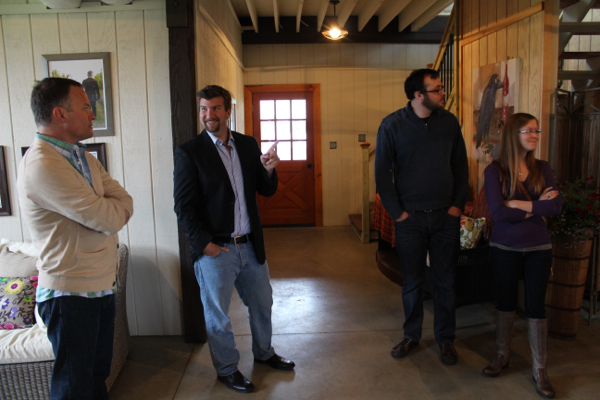
Bryan’s warm welcome made us feel right at home at Stone Tower Winery, and he conducted a tour of the vineyard as well as the winery’s new construction site via golf cart. (I had never been on a golf cart, so I was excited!) Owners Michael and Kristi Huber own over 200 acres of property on the Stone Tower Winery site, and over 20 acres are currently planted as vineyards. Chardonnay and Viognier make up at least six acres of the vineyard with plans to expand white varietals to include Sauvignon Blanc and Semillion. Red grape plantings include Cabernet Sauvignon, Cabernet Franc, Petit Verdot and Merlot. Vineyard practices favor tight spacing to manage nutrients and moisture, and these decisions are made in consultation with viticulture expert Lucie Morton. The vineyards enjoy a high elevation to maximize proper airflow and drainage. However, like all Virginia vineyards, there are indeed challenges in the vineyard at Stone Tower Winery. Unpredictable weather, rot, and disease can throw a curve ball to any vineyard, and Stone Tower Winery stays ahead of the game with a management program that blends both traditional and organic methods to ward off dangers to healthy vines.
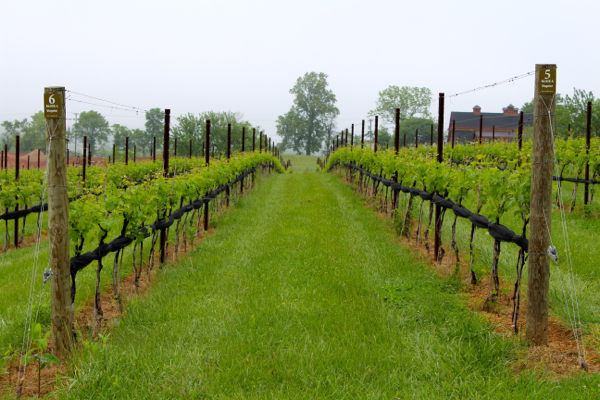
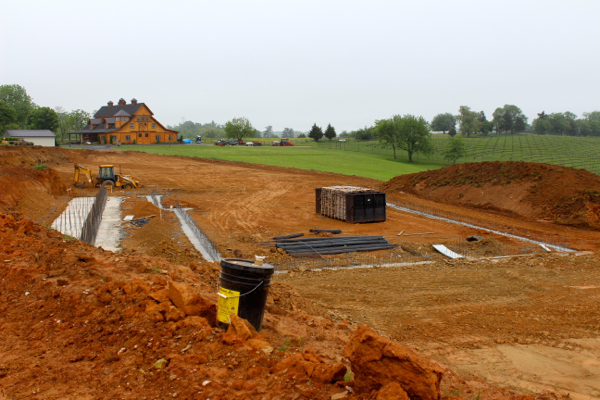
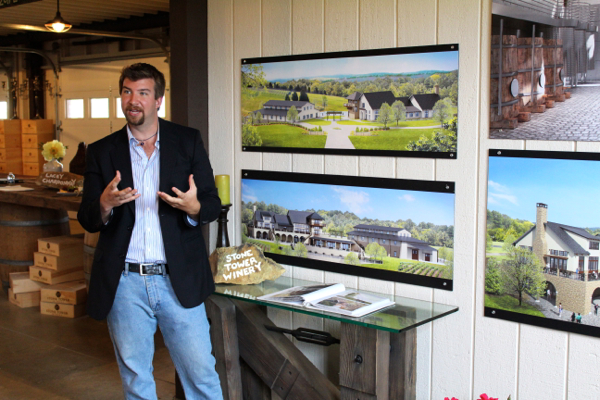
Our on tour was the construction site for the new tasting room and events facility. Space will be cleared in the future for this facility, and it has been designed so that an event such as a wedding and daily business such as wine tasting for costumers can proceed without interfering with each other. In addition to this facility, a new production building is also in the works with an emphasis on state of the art equipment and a sterile environment. The footings have already been poured and construction will begin soon. The goal here is to continue the winemaking excellence associated with Stone Tower Winery. In fact, Napa winemaker Tim Crowe will assume the helm as winemaker at Stone Tower Winery on June 1. Crowe’s appreciation for Virginia’s unique opportunities (and challenges) as well as his dedication to a team effort in the winemaking process suggest that great wines will be poured at Stone Tower Winery.
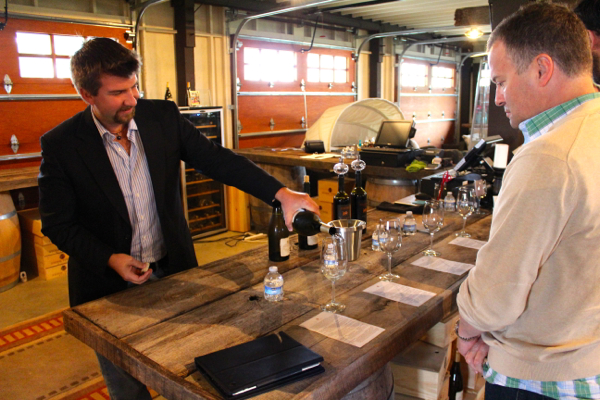
Of course, we are all about the wines. Grand tasting rooms and scenic views are one thing, but quality wines to support it all are more important. Bryan led us to the tasting room and guided us through a sample of the current releases at Stone Tower Winery. Three whites were offered for tasting, and these included the 2012 Lacey’s Chardonnay, the 2012 Viognier (a blend of neutral oak and concrete egg), and a 2012 Viognier produced from a concrete egg. (Yes, a concrete egg. It looks like an atomic bomb and is used most often in France.) We both agreed that the 2012 Lacey’s Chardonnay was the best white wine. Abundant pear notes with a fuller mouth feel made for a wine that was not only a sipper on its own but also a food friendly wine. I’d serve this one with poultry or white fish. Of the two Viogniers, we were split. Paul preferred the blended Viognier with its floral notes and spicy finish; however, I really enjoyed the more fruit forward Viognier done in the concrete egg. Characteristic floral aromas were noted but with a richer palate of stone fruits.
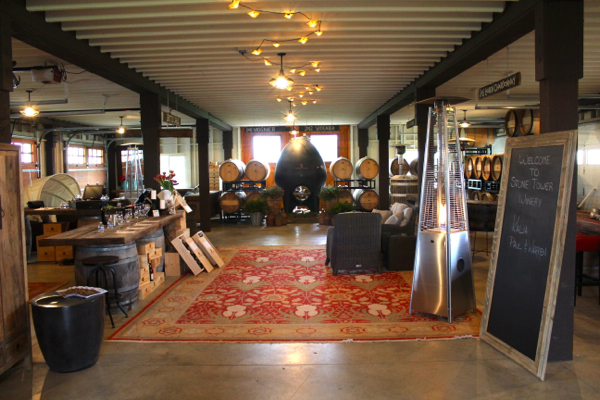
Two red wines were offered for tasting, and these included the 2011 Sanglier Noble and the 2009 Sanglier Noble. Both were blends under the Wild Boar label; label is used to designate wines that were produced from fruit not entirely grown on the Stone Tower estate. Paul and I reached a split decision on the reds. Paul preferred the fruitier, lighter-bodied 2011 Sanglier Noble, a blend of Cabernet Sauvignon, Merlot, Petit Verdot and Cabernet Franc. He noted bright berry aromas and flavors with a note of lavender. My own preference was for the 2009 Sanglier Noble; though a similar blend of grapes, this one was more complex with elements of cherry, sweet tobacco, and dried herbs. I also caught a whiff of violet.
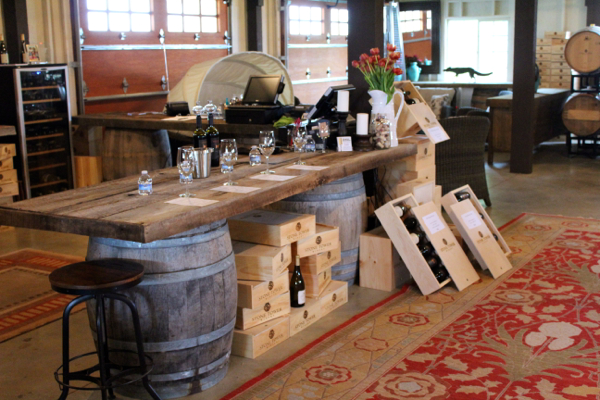
With our tastings done, we concluded that Stone Tower Winery is indeed making quality wines with a plan to continue a path to winemaking excellence; newer facilities will only enhance the ability to enjoy these wines. This sort of undertaking is only successful if qualified individuals work together to make it happen, and this is certainly the case at Stone Tower Winery. Before we left the winery, we made certain to purchase bottles of our favorite wines. We encourage readers to plan an appointment at Stone Tower Winery, and please mention that Virginia Wine Time sent you!
Category: Winemakers
Gray Ghost Blending Class
On May 4th we attended the third annual Blending Class at Gray Ghost Vineyards. The outcome of the class was to create a Meritage or Bordeaux style blend using at least three of the five Bordeaux grapes. To be considered a Meritage (or Bordeaux blend), a wine must consist of a combination of any or all of these varietals: Cabernet Sauvignon, Merlot, Cabernet Franc, Malbec, and Petit Verdot. No single varietal can make up more than 50% of the blend. We were trying to create a blend that was similar to the award winning Ranger Reserve. Our class began with winemaker Al Kellert teaching us about the different Bordeaux grapes. We learned about the flavor profiles for each grape and some history before getting started.
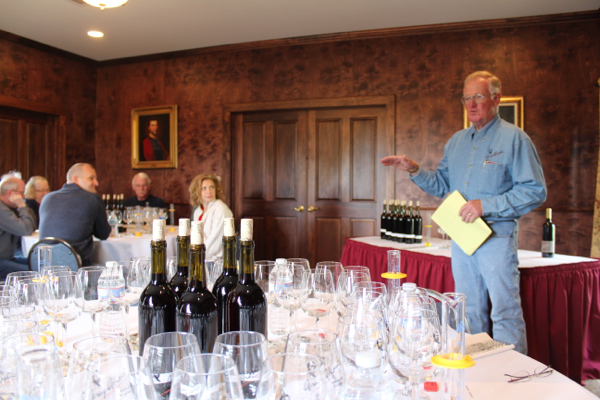
After our lesson on the individual grapes, we got to work on our blends. We began by tasting each of the five grapes separately. All the wines were from the 2011 vintage. As we tasted each of the grapes we kept notes about each one. We wrote down what we thought was prominent in each wine. We thought about things like the nose, the color, the flavors we were getting, the ending, and the tannins. After taking our notes and thinking about the individual wines, we then began the process of putting certain percentages together to create our blends. Since Al had not told us what the blend percentages were for the 2011 Ranger Reserve, we had no idea how much to include from each wine. It was up to our palates to decide what percentages of the wines we liked best. We used our pipettes to put different percentages in our beaker to create the final blend. We were able to blend two different times to get to the one we liked best. After testing and tasting a few times I came up with my final blend. My final blend was actually VERY close to the final blend of the 2011 Ranger Reserve.
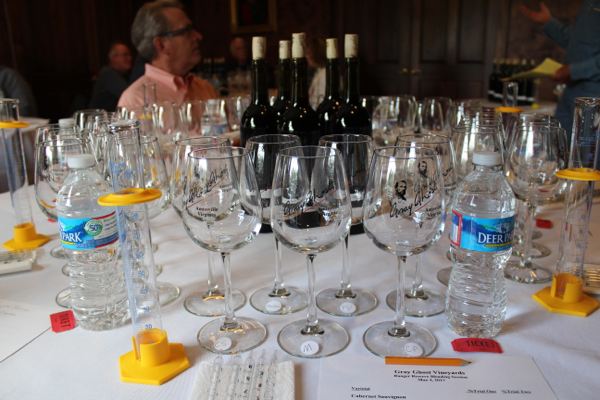
My blend consisted of 30% Cabernet Sauvignon, 20% Merlot, 20% Cabernet Franc, 15% Malbec, and 15% Petit Verdot. The 2011 Ranger Reserve blend is 34% Cabernet Sauvignon, 17% Merlot, 17% Cabernet Franc, 16% Malbec, and 16% Petit Verdot. Al was pretty impressed how close I got to the 2011 blend. I was pleased with the outcome.
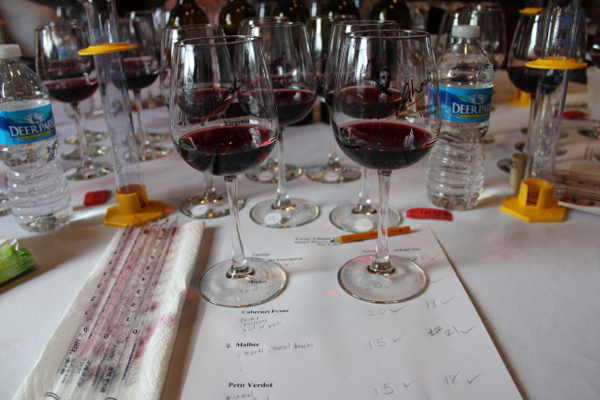
My favorite individual varietal was the 2011 Malbec. I think most participants enjoyed the malbec as well. The only problem with using malbec as the main ingredient is that Al doesn’t produce enough to create a malbec dominated blend. He informed us that if we used a high percentage of malbec, he’d only have one barrel of the blend to sell. Knowing this, many of the participants changed their blend in the second round to reflect this. I preferred my first blend as my finest. Warren joined me for the class but his allergies were keeping him from truly enjoying the nose and flavor profiles of each wine. He still came up with a pretty decent blend.
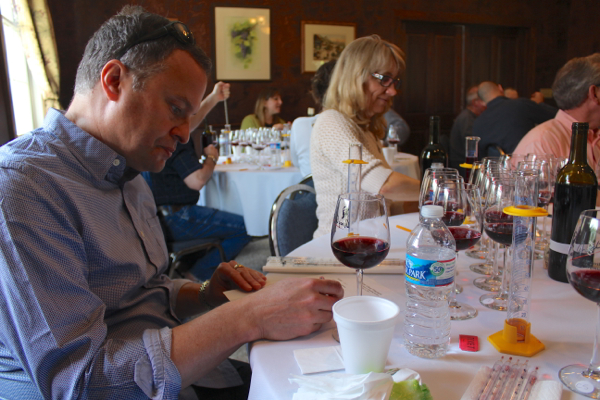
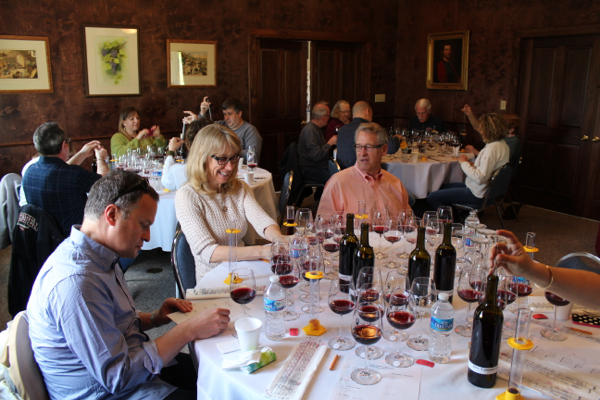
After our class we enjoyed a box lunch and a glass of wine on the patio. Al and Cheryl joined us during lunch. It was fun chatting about the class and about Virginia wine. We always have a great time at Gray Ghost. If you haven’t been to Gray Ghost lately, plan a trip soon. And tell them Virginia Wine Time sent you!
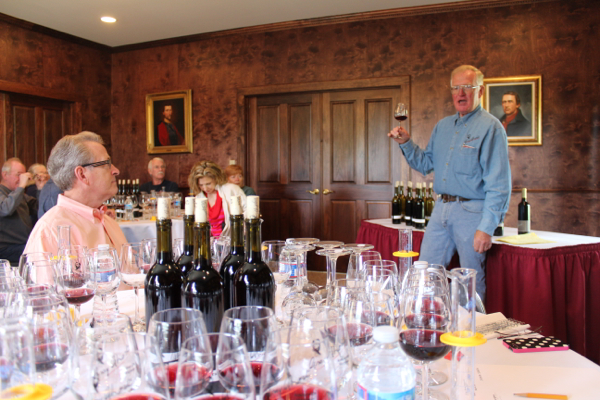
Delaplane Cellars
After the special release tasting we attended at Linden Vineyards recently, we decided to visit a few other wineries in the area. Our first stop was Delaplane Cellars. Being a club member and electing to pick up the shipments instead of having them shipped makes it possible to visit Delaplane often to see what’s new and taste the most current wines. Warren had a shipment to pick up so we decided to visit Delaplane.
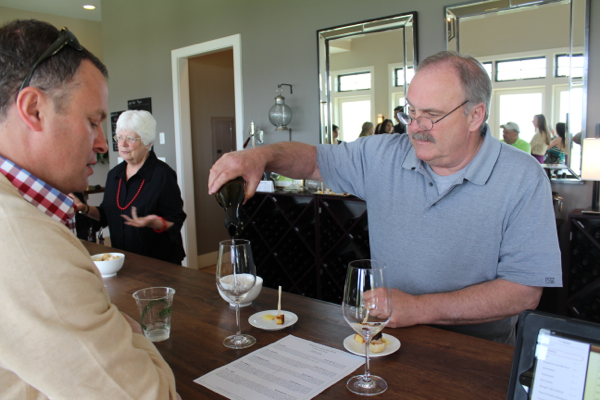
Jim Dolphin was there that day and conducted our tasting. The day we attended they were having a special pairing with some of the wines on the tasting menu. Our first wine was the 2012 Rose paired with a pork roulette with strawberry preserves. We noted strawberry, melon, and spice. This would make a nice sipping wine for a concert at Wolf Trap. The second wine/food pairing was the 2012 Viognier paired with toasted cornbread and local honey. Warren and I both thought this was a classic viognier with a floral nose, and honeysuckle and apricot in the mouth. The cornbread was a nice touch with the viognier. We really enjoyed this viognier. The final wine/food pairing was the 2011 Cinq3 paired with Caromont Red Rowe cheese. This one presented some bright fruit flavors with notes of smoke, coffee, and menthol. While I enjoyed the wine, I didn’t care for the cheese so I let Warren finish my piece with his wine. While not paired with foods, we also tasted the 2012 Melange Blanc and the 2011 Merlot.
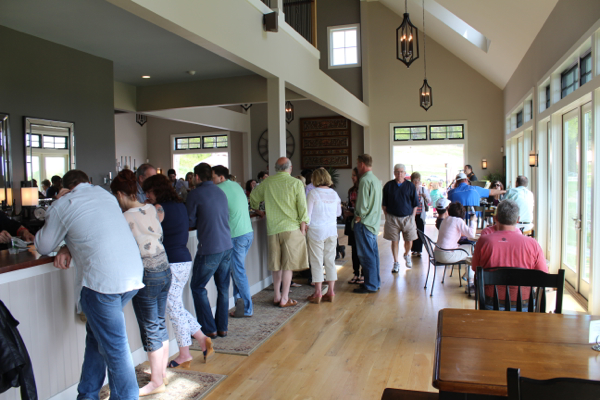
During our tasting we chatted with Jim about wine of course and he said of the 2010 and 2011 vintages, “It was the best of times and the worst of times.” That pretty much sums up the differences between the two seasons. Some of the 2010s still aren’t quite ready while the 2011s are wines to enjoy right now. During our conversation with Jim, he let us taste the 2012 Petit Manseng. The petit manseng has 5% RS but is integrated so well you are barely aware of the sweetness. We noted tropical fruit and a nice mouth weight. Jim also let us taste the 2010 Williams Gap. I remember loving this one at the barrel tasting a few years ago so I was curious to see how it was developing in the bottle. The first sip informed me it was coming along nicely. I enjoyed it now as much as I did then. We noted some nice fruit, anise, tobacco, and developing smooth ending. We’ll need to try to get a bottle of this for the wine rack sometime.
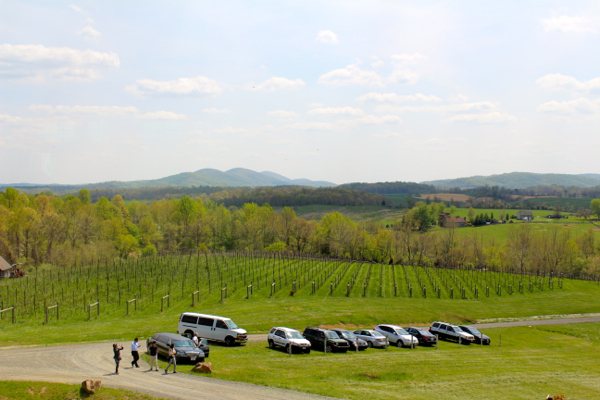
With our tasting and conversation complete, we decided to enjoy a glass of the 2012 Viognier with the wonderful views. We enjoyed the viognier so much that we included it as part of the #vawinechat Twitter tasting on May 2nd. Lots of Virginia wine bloggers and winemakers joined in for a Twitter tasting of Virginia viogniers. We enjoyed the 2012 Viognier as part of the tasting. We shared our impressions of the wine on Twitter for others to enjoy. Join us on Twitter sometime and participate in the #vawinechat events. The next one is on May 16th. We’ll be tasting and Twitting about Virginia red blends. And the next time you visit Delaplane Cellars be sure to tell them Virginia Wine Time sent you!
Special Tasting at Linden
Winemaker Jim Law held a special release tasting of upcoming wines at Linden. We look forward to attending this annual event, and this year was no exception. Gorgeous spring weather, bursting blossoms, and fluttering birds provided an idyllic setting to boot.
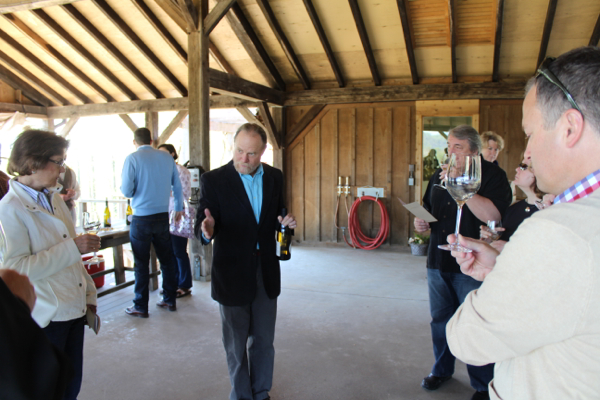
The event featured five tasting stations, and the first station was located on the outdoor crush pad and appropriately named First Sip. Chardonnay was the star attraction here, and there were four of them to sip. These included the 2011 and 2010 Avenius Chardonnay followed by the 2011 and 2010 Hardscrabble Chardonnay. The Avenius site is known for its rocky soils and thus produces leaner wines with mineral characteristics; we both agreed that the 2011 better presented these unique qualities of the Avenius vineyard. Shellfish will be perfect with one! The Hardscrabble site with its clay soils produce fuller-bodied wines; of the two, I preferred the 2010 Hardscrabble Chardonnay with its richer mouth feel.
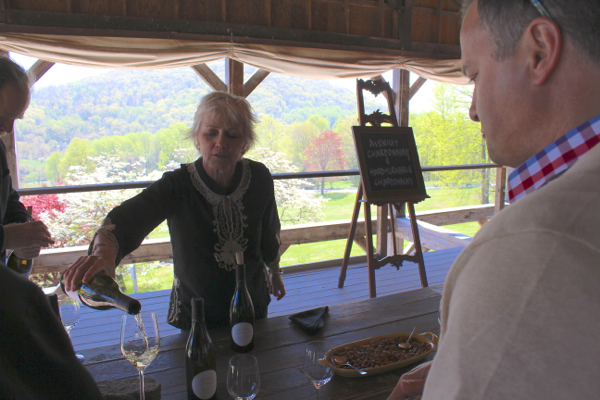
From the white wine station, we moved on to the red wines held in the barrel room. We moved through four tables that presented a total of seven red wines. The first table featured a 2010 Cabernet Franc, and this will be the first time that Law has released a single-varietal bottling of Cabernet Franc in quite some time; however, the 2010 Cabernet Franc proved to be jammier and more muscular than in previous years. Law therefore opted to bottle it on its own. We approved of the decision and enjoyed our sample with a spicy lamb meatball.
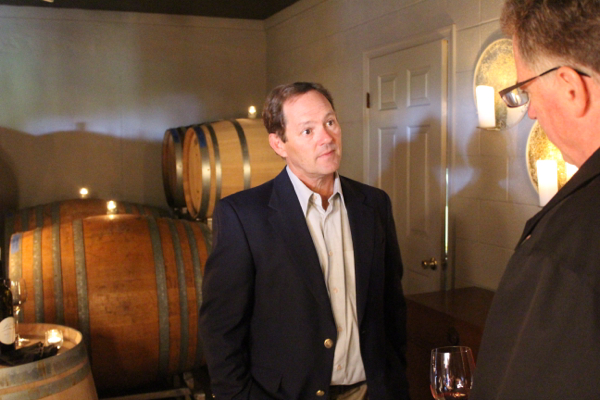
The other tables provided more opportunities to sample wines from the 2009 and the 2010 vintages. In all cases, we tended to prefer the 2009 pours. The most accessible was the 2009 Boisseau Red, a blend of 43% Merlot, 31% Cabernet Franc, and 26% Petit Verdot. The 2009 Hardscrabble Red proved to be the most complex and was dominated by Cabernet Sauvignon (64%) then Merlot (14%) and Petit Verdot (3%). Paul was a big fan of the 2009 Avenius Red with its plum notes and earthy elements.
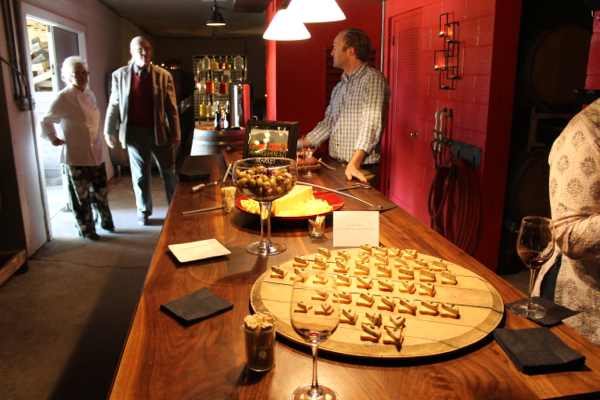
Though we did enjoy the 2009 vintages, it was hard to ignore the potential for the 2010 red wines. The 2010 harvest was best since the heralded 2007 season, and it was telling that Cabernet Sauvignon heavily dominated all of the 2010 blends. I am always a fan of the Hardscrabble reds, and once again the 2010 Hardscrabble Red was my favorite of the still evolving 2010 blends. Remember, though, that the 2009 blend contained 64% Cabernet Sauvignon. The 2010 version? 83% I have no doubt that the 2010 Hardscrabble Red will have great cellaring potential once it is released.
We completed our release tasting and then opted to try the current releases in the tasting room. Here again we were able to taste a contrast of seasons. Law has released a 2011 Red, a bright and light bodied red blend that would be suitable with a pizza, burger, or spicy fare. (I called this one a Beaujolais-style wine due to its soft, fruity nature, but I’m not sure if Jim would consider it a complement.) Anyway, it was the product of a very rainy and difficult year yet it was very quaffable. Be sure to enjoy soon, though. It might be an option for Thanksgiving dinner, too. (Paul ended up buying two bottles!). On the other hand, the 2010 Claret was more complex with smoky notes and ripe dark fruit flavors. Steak on the grill? This would pair nicely. Unlike its younger sibling, this one will be able to hang out on the wine rack for a while.
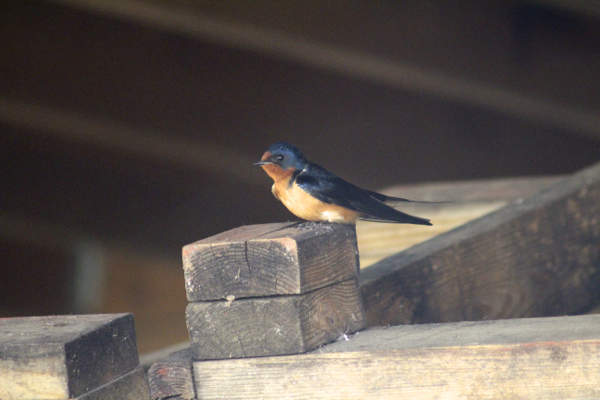
Our tastings were done, and we decided to linger for a while with a glass of our favorites. I savored a glass of the 2009 Hardscrabble Red, and Paul enjoyed a glass of the 2009 Avenius Red. We munched on a smoky gouda cheese, summer sausage, and a baguette, and Paul snapped pictures of barn swallows as they flew back and forth between a dark space beneath the deck and nearby trees.
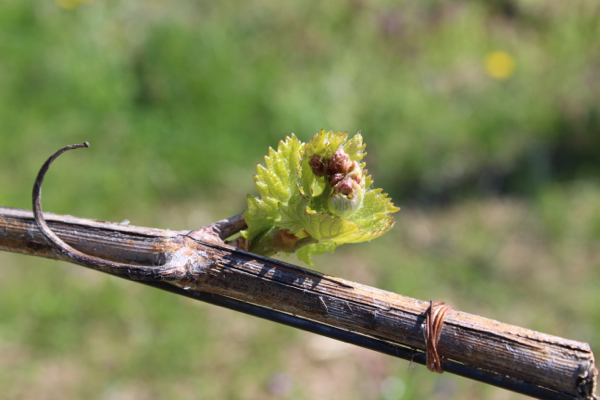
We enjoyed our special release tasting and made sure to purchase some very special wines. Plan a trip to Linden, and mention that Virginia Wine time sent you.